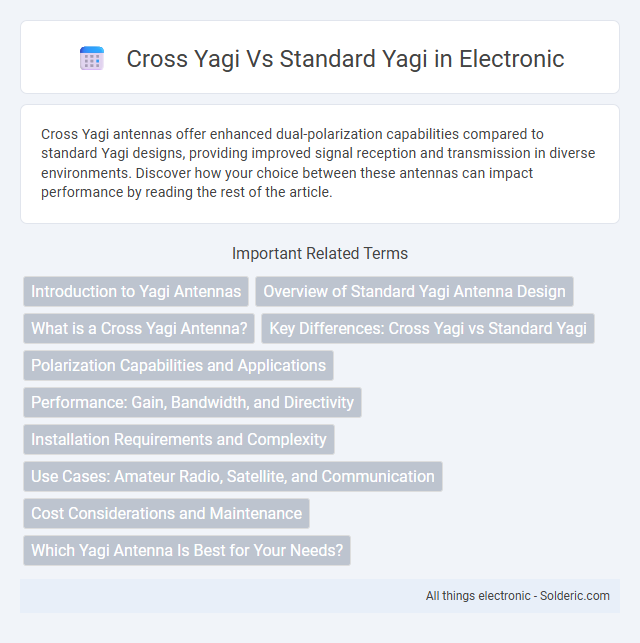Cross Yagi antennas offer enhanced dual-polarization capabilities compared to standard Yagi designs, providing improved signal reception and transmission in diverse environments. Discover how your choice between these antennas can impact performance by reading the rest of the article.
Comparison Table
| Feature | Cross Yagi | Standard Yagi |
|---|---|---|
| Polarization | Dual-polarized (typically horizontal and vertical) | Single polarization (usually horizontal or vertical) |
| Design | Two Yagi arrays mounted perpendicularly | Single linear Yagi array |
| Application | Improved signal diversity and polarization matching | Directional signal transmission and reception |
| Gain | Moderate, balanced for both polarizations | Higher gain for specified polarization |
| Interference Rejection | Better cross-polarization interference reduction | Less effective against cross-polarized interference |
| Complexity | More complex design and installation | Simple design, easier installation |
| Use Case | Satellite communications, monitoring, and MIMO systems | Amateur radio, TV reception, point-to-point links |
Introduction to Yagi Antennas
Yagi antennas, essential in radio and television signal reception, come in variations such as the standard Yagi and the cross Yagi, each designed for specific applications. The standard Yagi features a single driven element with multiple parasitic elements aligned linearly to achieve high directionality and gain. In contrast, the cross Yagi incorporates two orthogonally polarized Yagi antennas combined to enhance signal reception by mitigating polarization mismatch and improving performance in multipath environments.
Overview of Standard Yagi Antenna Design
The standard Yagi antenna features a single driven element, typically a dipole, accompanied by multiple parasitic elements including a reflector and several directors, all aligned linearly to enhance directional gain. Its design focuses on maximizing forward gain and front-to-back ratio by controlling element spacing and lengths based on the operating frequency. This configuration is widely used in television reception, amateur radio, and point-to-point communication systems due to its simplicity and high directivity.
What is a Cross Yagi Antenna?
A Cross Yagi antenna consists of two Yagi antennas mounted perpendicularly and fed with a phase difference to achieve circular polarization, enhancing signal reception in satellite communication and amateur radio applications. Unlike a standard Yagi, which offers linear polarization and directional gain, the Cross Yagi provides better resistance to signal fading caused by polarization mismatch. Your choice of antenna impacts communication quality, especially when signal orientation varies or multipath interference is present.
Key Differences: Cross Yagi vs Standard Yagi
Cross Yagi antennas feature two perpendicular arrays with orthogonal polarization, enhancing signal reception in multiple planes, while Standard Yagi antennas have a single linear polarization. Cross Yagi designs improve performance in environments with varying signal orientations and multipath interference. Standard Yagi antennas prioritize higher gain and directivity in a single polarization, making them ideal for targeted, long-distance communication.
Polarization Capabilities and Applications
Cross Yagi antennas provide dual polarization capabilities by combining two Yagi arrays oriented orthogonally, enabling reception and transmission of both horizontal and vertical signals, which enhances signal diversity and reduces multipath interference. Standard Yagi antennas offer single linear polarization, typically horizontal, making them suitable for applications where polarization diversity is less critical. Cross Yagi antennas are preferred in radar, satellite communication, and advanced wireless systems requiring circular or dual polarization, while standard Yagi antennas remain effective for point-to-point communication and broadcast where simpler polarization suffices.
Performance: Gain, Bandwidth, and Directivity
Cross Yagi antennas offer enhanced performance over standard Yagi designs by providing improved gain and wider bandwidth, making them suitable for applications requiring versatile frequency coverage. Their distinctive element arrangement allows for superior directivity and polarization diversity, which can reduce signal interference and improve overall reception quality. If your goal is maximizing signal strength and clarity in challenging environments, a cross Yagi antenna may be the optimal choice.
Installation Requirements and Complexity
Cross Yagi antennas often require more intricate installation due to their dual-polarization design, demanding precise alignment and additional mounting hardware compared to standard Yagi antennas. Standard Yagi antennas are typically easier to install, featuring a straightforward structure with a single linear polarization and fewer elements, reducing setup time and complexity. Your choice should consider the available mounting space and technical expertise to ensure optimal performance and stability.
Use Cases: Amateur Radio, Satellite, and Communication
Cross Yagi antennas are ideal for satellite communication and amateur radio operators seeking circular polarization to reduce signal fading caused by polarization mismatch, enhancing communication quality with satellites and spacecraft. Standard Yagi antennas are commonly used for terrestrial amateur radio and communication due to their high gain and directional properties, making them effective for point-to-point line-of-sight applications. Your choice between cross Yagi and standard Yagi depends on whether you prioritize circular polarization for satellite signals or straightforward directional gain for ground-based communication.
Cost Considerations and Maintenance
Cross Yagi antennas typically have higher initial costs due to their complex design and dual-polarization elements, while Standard Yagi antennas are more affordable and easier to produce. Maintenance for Cross Yagi antennas can be more demanding because of additional components requiring regular checking and alignment, whereas Standard Yagi antennas benefit from simpler construction, leading to lower upkeep expenses. Selecting the right antenna involves balancing your budget against the desired performance and long-term maintenance commitments.
Which Yagi Antenna Is Best for Your Needs?
Choosing between a Cross Yagi and a Standard Yagi antenna depends on your specific communication goals and environment. The Cross Yagi excels in polarization diversity, reducing signal fading and improving reception in multipath conditions, ideal for mobile or satellite applications. Standard Yagi antennas offer higher gain and directivity, making them suitable for long-distance point-to-point communication where signal strength and precision are critical.
cross yagi vs standard yagi Infographic

 solderic.com
solderic.com